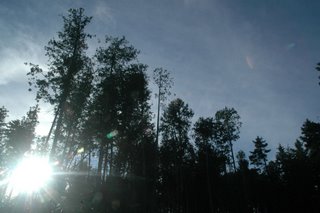Green Acres

Since the rain has delayed our foundation work, I'm looking for ways to make myself feel better about this house. Therapy is a must, I say.
Here are a few pro-environmental choices we have made:
1. Low-e coating and argon gas windows for energy efficiency.
2. Passive solar elements - facing most of glazing south with a roof overhang that will block the hot, high summer sun, and welcome the low, warm winter sun. It will heat the concrete floor during the day, which will help keep the house warm during the cold nights.
3. Straw bale walls are R32-R50, making them very energy efficient. PLUS, straw is an annually renewable resource that is a bi-product of grain production.
4. Our insulated roof panels are R-40, complimenting our straw bale insulation.
5. Recycled materials will be used where possible - antique light fixtures, an exteriour door, building materials like boards, misc tools etc.
6. In-floor radiant heat will heat the thermal mass of our house (our slab floor), and reduce long-term heating costs.
7. The timber frame is not an annually renewable resource, but we are using underutilized local wood species, rather than shipping Douglas Fir in from BC.
8. Solar thermal panels are being installed to supplement our domestic hot water heating.
9. Local clay and sand will be used for our earth plasters rather than cement, which is created using energy-intensive production techniques.
10. Minimal glazing will be featured on the north side of the house, reducing cold during the winter months.
11. A covered porch on the north side of the house creates a rain screen effect, shielding the house from harsh winter weather.
12. A shallow frost-free monolithic slab will serve as our foundation, using significantly less concrete than a four-ft stem wall or a basement. Plus, it's well insulated on the outside edge and underneath, so less heat will escape.
13. Metal roofing will be installed so that we can collect rain water for use in our gardens.
14. Natural silicate and casein paints will be used instead of latex paints. These options do not "off-gas" the chemicals of latex paints into a household environment, plus they ensure that the straw still "breathes" properly.
15. Native plants will be used for landscaping and minimal grass will be incorporated to remove our need for an electric or gas lawnmower. We've also transplanted tonnes of trees ahead of the destruction of excavation.
16. The location puts us 2/3 closer to work, reducing our gasoline consumption equally and placing us on a new public transit route.




1 Comments:
PS: A few things we plan to do in future:
-energy efficient appliances
-more solar/renewable energy
-grey water system
-non toxic furniture, esp. bed mattresses
Post a Comment
<< Home